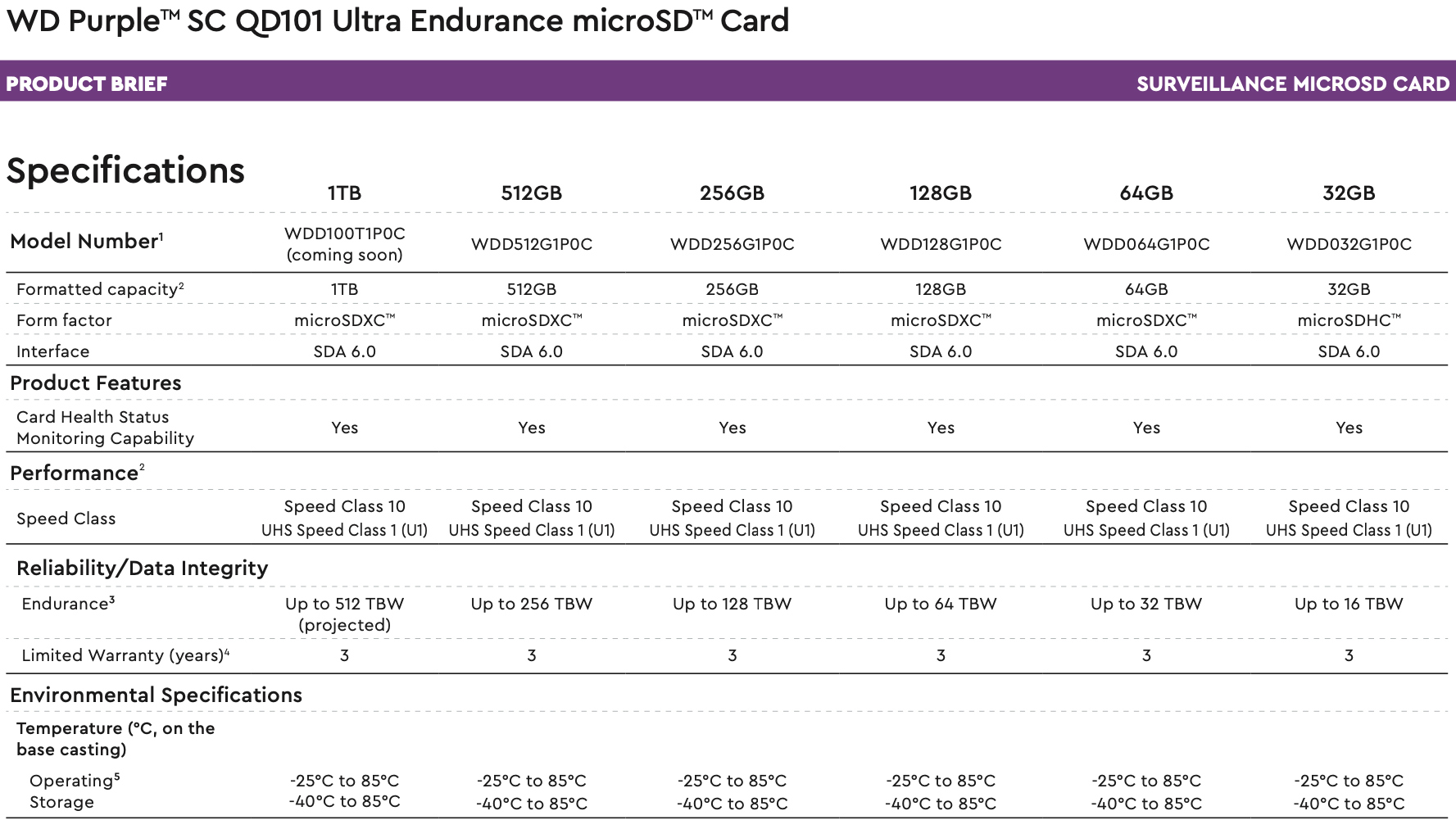Western Digital Has 1TB microSD Card for Surveillance: 16 Years Lifespan
Western Digital this week announced that it has expanded its family of WD Purple SC QD101 microSD cards designed for compact and mobile surveillance applications with a 1TB model. In addition to offering a record capacity, the new card can survive harsh environments and, if used properly, promises to have an extremely long lifespan of up to 16 years.
The WD Purple SC QD101 1TB microSD card is based on Western Digital’s BiCS4 96-layer 3D NAND memory and use a proprietary controller that supports card health status monitoring capability enabling operators to replace a card that is about to fail for some reason. The card uses a UHS-I bus, so its peak sequential read/write speeds will be comparable those of other modern WD Purple microSD cards (i.e., 60 MB/s reads and 100 MB/s writes), it also carries the Speed Class 10 as well as UHS Speed Class 1 badges, so it guarantees a minimal write speed of 10 MB/s.
The WD Purple SC QD101 card can withstand temperatures from -25°C to 85°C and can survive bad weather as well as high humidity. Quite naturally, the microSD product is also designed for a 24/7 operation.
Western Digital says that its WD Purple SC QD101 1TB microSD card is rated for up to 512 program/erase cycles (i.e., 512TB to write), which does not seem good enough by SSD standards. Meanwhile, there are three things to point out. Firstly, SD controllers do not support an advanced LDPC-based ECC technology, so memory cards cannot provide the same level of endurance as SSDs. Secondly, surveillance flash cards write data sequentially in most cases and that pretty much guarantees a low write amplification and a higher endurance when compared to applications that write randomly in most cases (e.g., SSDs). Thirdly, at ~60 MB/s, it will take 5926 days, or over 16 years, to write 512TB of data on this card. The product is covered with a three-year warranty, so its actual capabilities well exceed the warranty.
There is a catch about endurance though. When using the card for non-surveillance applications that do many random writes, some cells might fail after some time since the card is optimized primarily for sequential workloads.
Western Digital’s WD Purple SC QD101 1TB microSD card will be available this November. The price is to be announced later, but given that the product is intended for surveillance solutions, it is likely that makers of the latter will pay a price that will depend on volumes and other arrangements.
Get Tom's Hardware's best news and in-depth reviews, straight to your inbox.

Anton Shilov is a contributing writer at Tom’s Hardware. Over the past couple of decades, he has covered everything from CPUs and GPUs to supercomputers and from modern process technologies and latest fab tools to high-tech industry trends.
-
linuxdude ReplyThirdly, at ~60 MB/s, it will take 5926 days, or over 16 years, to write 512TB of data on this card. The product is covered with a three-year warranty, so its actual capabilities well exceed the warranty.
The 16 years were so unbelievable I had to start my calculator and check for myself: With 60 MB/s I came to a livespan of ~99 days.
Firstly, SD controllers do not support an advanced LDPC-based ECC technology, so memory cards cannot provide the same level of endurance as SSDs.
Says who? -
fevanson Replylinuxdude said:The 16 years were so unbelievable I had to start my calculator and check for myself: With 60 MB/s I came to a livespan of ~99 days.
Says who?
Here is the simple math 60mb/s * 60 seconds * 60minutes * 24 hours = 5,184,000 MB/1024MB/GB = 5062.5 GB/DAY = 5062.5GB/1024GB/TB = 4.944 TB/Day Write theoretical maximum.
So 512TB/4.944TB/day = 103.55 days theoretical minimum days the sd card will last before replacement.
You have a miscalculation TomsHardware Editor, please fix it. -
DZIrl 512 erase cycles is "real" number for TLC. They probably use same FLASH in SSDs and only thanks to controller it might survive longer.Reply
Big question: does card internally takes care of wear leveling or is it on device?
If on device then using such card in mobile might be problematic.
Something on speed. Shouldn't be read speed higher then write? -
linuxdude ReplyDZIrl said:Big question: does card internally takes care of wear leveling or is it on device?
If on device then using such card in mobile might be problematic.
All sd cards do wear leveling on the device - SD defines a simple block device, so the device which accesses the card does not have to worry about the internal structure / flash / ...
